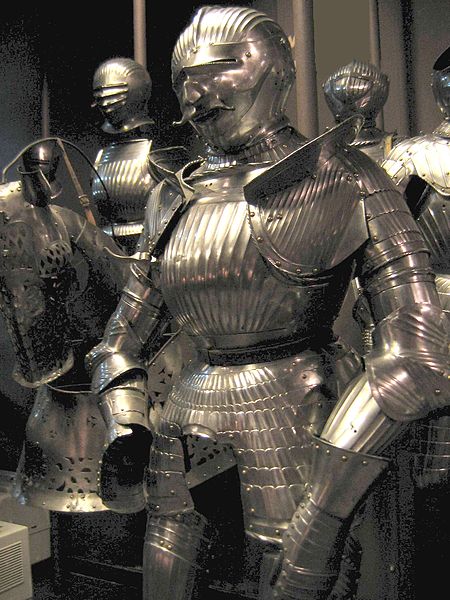Maximilian armour is a modern term applied to the style of early 16th-century German plate armour associated with, and possibly first made for the Emperor Maximilian I. The armour is still white armour, made in plain steel, but it is decorated with many flutings that may also have played a role in deflecting the points and blades of assailants and increasing the structural strength of the plates. It is a transitional stage in the decoration of armour, after the plain steel surfaces of 15th-century armour and before the elaborate decoration and colouring with etching and other techniques of Renaissance armour. The armour is characterized by armets and close helmets with bellows visors; small fan-shaped narrow and parallel fluting—often covering most of the harness ; etching; work taken from woodcuts; sharply waisted cuirasses, and squared sabatons.

Maximilan armour with grotesque mask. In the background are two other Maximilian suits of armour with sparrow-beaked and bellows-shaped visors. Photo taken in the Polish Army Museum.
Schott-Sonnenberg Style of Armour (worn with sallet and gothic gauntlets)
Burgkmair – S. Croce – Basilica Cycle 6
Fluting and imitation slashed or quilted fabrics
Plate armour is a historical type of personal body armour made from bronze, iron, or steel plates, culminating in the iconic suit of armour entirely encasing the wearer. Full plate steel armour developed in Europe during the Late Middle Ages, especially in the context of the Hundred Years' War, from the coat of plates worn over mail suits during the 14th century.
Full plate armour for man and horse commissioned by Sigismund II Augustus, Livrustkammaren in Stockholm Sweden (1550s).
Bronze muscle cuirass, Italy, c. 350–300 BC
A Japanese 16th–17th century suit of plate armour with a western-style cuirass (nanban dō gusoku)
Italian suit of armour with sallet, c. 1450








